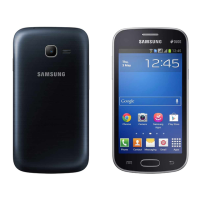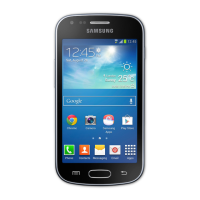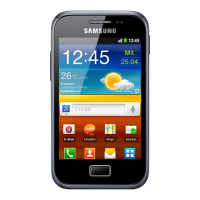
Do you have a question about the Samsung GT-S7275R and is the answer not in the manual?
| Brand | Samsung |
|---|---|
| Model | GT-S7275R |
| Category | Cell Phone |
| Language | English |
Information on safe and proper device use, software variations, and service provider terms.
Explanation of symbols used in the manual for warnings, cautions, and notes.
List of registered trademarks and copyrights of Samsung and other companies.
Diagram showing the location of external buttons, cameras, sensors, and ports on the device.
Explanation of the functions of the Power, Menu, Home, Back, and Volume buttons.
List of items included in the product box and guidelines for accessories.
Instructions for inserting the SIM/USIM card and the battery into the device.
Steps for safely removing the SIM/USIM card and the battery from the device.
Instructions for charging the device battery using the charger or a computer.
How to check battery level and tips for extending battery life by managing device settings.
Guide on how to insert a memory card, supported formats, and precautions.
Steps for safely removing and formatting the memory card on the device.
Instructions for turning the device on and off, including flight mode activation.
Guidance on how to hold the device, avoiding antenna obstruction.
Methods to lock and unlock the device screen to prevent unintended operations.
How to adjust device volume and switch between ringtone and silent modes.
Explanation of common icons displayed on the status bar for device status.
Guidelines for using the touch screen and precautions to avoid damage or malfunction.
How to use the tapping gesture to interact with on-screen elements.
Instructions for using drag and double-tap gestures for navigation and zooming.
How to use flicking for scrolling and pinching for zooming on the touch screen.
Explanation of how to activate and use device motion controls for interaction.
How the screen orientation changes and how to control automatic rotation.
Using pickup gestures and understanding notification icons on the status bar.
Accessing and using quick settings for Wi-Fi, GPS, Sound, Bluetooth, and more.
Overview of the Home screen layout, panels, and accessing device features.
Steps to add, move, remove, and rearrange application icons, widgets, folders, and panels.
How to set device wallpaper and add widgets to the Home screen.
Adding and managing widgets on the locked screen for quick access.
Opening, closing, and rearranging applications on the device.
Organizing apps in folders, installing, uninstalling, sharing, and accessing help.
Using the Samsung keyboard, changing layouts, and entering uppercase characters.
Using handwriting input, voice dictation, and copy/paste functionality.
Steps to turn Wi-Fi on/off, join networks, add new networks, and forget networks.
Creating and managing Google and Samsung accounts for device services.
Transferring files via USB using Samsung Kies or Windows Media Player.
Connecting the device to a computer as a media device (MTP/PTP).
Setting up face and voice unlock for device security.
Setting up screen lock using pattern, PIN, or password for device security.
Unlocking the device and upgrading software via Kies or over-the-air.
Searching the web by voice and activating/using Bluetooth for wireless connections.
Pairing Bluetooth devices, sending data, and using NFC for information and payments.
Using NFC for purchases and sharing data via Android Beam and S Beam.
Using the Phone app to make calls via keypad, logs, or contacts.
Managing calls during a conversation: hold, add call, speaker, mute, swap, merge.
Adding contacts, viewing call logs, fixed dialling, and call barring options.
Rejecting calls, auto-rejecting unwanted numbers, call waiting, and call forwarding.
Making and managing video calls, including switching cameras and hiding video.
Creating and managing contact information, including adding images and fields.
Editing, deleting, setting speed dial, searching, and displaying contacts.
Moving, importing, exporting, and sharing contacts with Google, Samsung, and via namecard.
Managing favourite contacts and organizing contacts into groups.
Creating a business card and sending SMS/MMS messages.
Sending scheduled messages and using the translation feature for messages.
Introduction to the Email application for sending and viewing email messages.
Setting up email accounts and composing/sending emails.
Reading email messages, opening attachments, and using Google Mail.
Sending, reading messages, and using labels in Google Mail.
Using Hangouts, Google+, and Messenger for chatting and social networking.
Using ChatON for cross-device chatting and managing contacts.
Playing music, managing playback, adjusting volume, and using shuffle/repeat modes.
Setting songs as ringtones, creating playlists, and playing music by mood.
Introduction to the Camera app for taking photos and videos.
Camera etiquette, taking photos, and using different shooting modes like Auto and Best photo.
Using Continuous shot, Sound & shot, Panorama, Sports, and Night shooting modes.
Recording videos, changing modes, and zooming in/out during recording.
Sharing photos and configuring camera settings like resolution, focus, and ISO.
Configuring GPS tag, timer, white balance, flash, storage, and customizing camera shortcuts.
Viewing images and videos, zooming, and trimming video segments in the Gallery.
Editing images, adding to favourites, deleting, and sharing images.
Sharing images, setting them as wallpaper, tagging faces, and using Tag Buddy.
Playing videos, deleting, sharing, and using the popup video player.
Watching, sharing, and uploading videos using the YouTube application.
Listening to FM radio, connecting headset, scanning stations, and adjusting volume.
Scanning for radio stations and adding favorite stations to the list.
Purchasing and downloading apps from the Play Store, including updates.
Downloading Samsung apps and accessing games via Samsung Apps.
Using Music Hub for streaming, purchasing music, and personalized radio stations.
Listening to music via Play Music and purchasing books/magazines from Readers Hub.
Composing, saving, editing, searching, printing, and sharing memos.
Managing events and tasks, creating new entries, and setting reminders.
Syncing S Planner events and tasks with Google Calendar.
Managing calendar views, searching/deleting events, and using Dropbox for file sync.
Syncing data with Samsung account or Dropbox, and backing up/restoring data.
Setting alarms, including location, snooze, and smart alarm features.
Stopping/deleting alarms, world clock, stopwatch, timer, and desk clock functions.
Performing calculations and using S Translator for text and spoken translation.
Recording, playing, and managing voice memos.
Managing voice memos, saving with tags, and using S Voice commands.
Searching the device, using images, and configuring search scope.
Using Google Now for personalized info and Voice Search for web queries.
Accessing files with My Files, managing downloads, and using TripAdvisor.
Searching for locations, getting directions, and using map layers.
Getting directions, using the Local app for nearby places, and searching categories.
Searching for routes, specifying destinations, and following navigation instructions.
Configuring device settings and managing Wi-Fi connections and sleep policy.
Managing network notifications, Wi-Fi Direct, Bluetooth, and data usage.
Configuring flight mode, mobile networks, tethering, and VPN.
Using NFC, S Beam, Kies via Wi-Fi, and configuring lock screen settings.
Customizing clock, personal message, shortcuts, and unlock effects on the lock screen.
Adjusting display settings like wallpaper, brightness, and sound settings like ringtones.
Customizing call settings for rejection, answering, ending, alerts, and accessories.
Additional call settings, ringtones, sound personalization, voicemail, and IP calling.
Configuring blocking mode, driving mode, safety assistance, and accessibility features.
Detailed accessibility options including TalkBack, TTS, and interaction controls.
Changing display language, default keyboard, and Google/Samsung keyboard settings.
Keyboard customization, handwriting, and voice search settings.
Configuring voice commands, wake-up commands, and Google voice recognition.
Text-to-speech, motions, smart screen, and managing accounts.
Managing backups, location services, and device security settings.
Encrypting SD card, remote controls, SIM lock, device administrators, and app verification.
Managing applications, viewing battery status, and managing device storage.
Accessing device information and configuring Google-specific settings.
Entering device codes (PIN, PUK) and resolving network or service error messages.
Troubleshooting device freezes, dropped calls, and audio issues during calls.
Resolving poor audio quality, battery charging problems, and device overheating.
Troubleshooting error messages when launching camera, FM radio, or music files.
Troubleshooting Bluetooth connection, computer connection, and minor physical gaps.











